Multi-Floor Indoor Pedestrian Dead Reckoning with a Backtracking Particle Filter and Viterbi-Based Floor Number Detection
Abstract
1. Introduction
- The combination of clustering, MBF of WiFi RSS, detection of both stairs and elevator usage and backtracking to reduce the multimodality problem with particle filters in the indoor PDR context and the step length and heading drift errors from the PDR algorithm;
- Floor number detection via WiFi RSS MBF and a floor transition detection algorithm, detecting both stairs and elevator usage by fusing accelerometer and barometer data;
- Integration into a complete infrastructure-independent localisation system, able to track pedestrians across multiple floors.
2. Related Work
2.1. Pedestrian Dead Reckoning
2.2. Map Matching with Particle Filters
2.3. Hybrid Localisation
2.4. Floor (Transition) Detection
3. Method
3.1. Pedestrian Dead Reckoning
3.1.1. Calibration and Preprocessing
3.1.2. Step (Length) Detection
3.1.3. Heading Estimation
3.2. WiFi RSS Aided Localisation
3.3. Floor Number Detection
3.3.1. Elevator Detection with the Accelerometer
| Algorithm 1 Floor transition detection. |
 |
3.3.2. Stairs Detection with Barometer
3.3.3. Viterbi-Based Floor Detection
| Algorithm 2 Viterbi floor detection. |
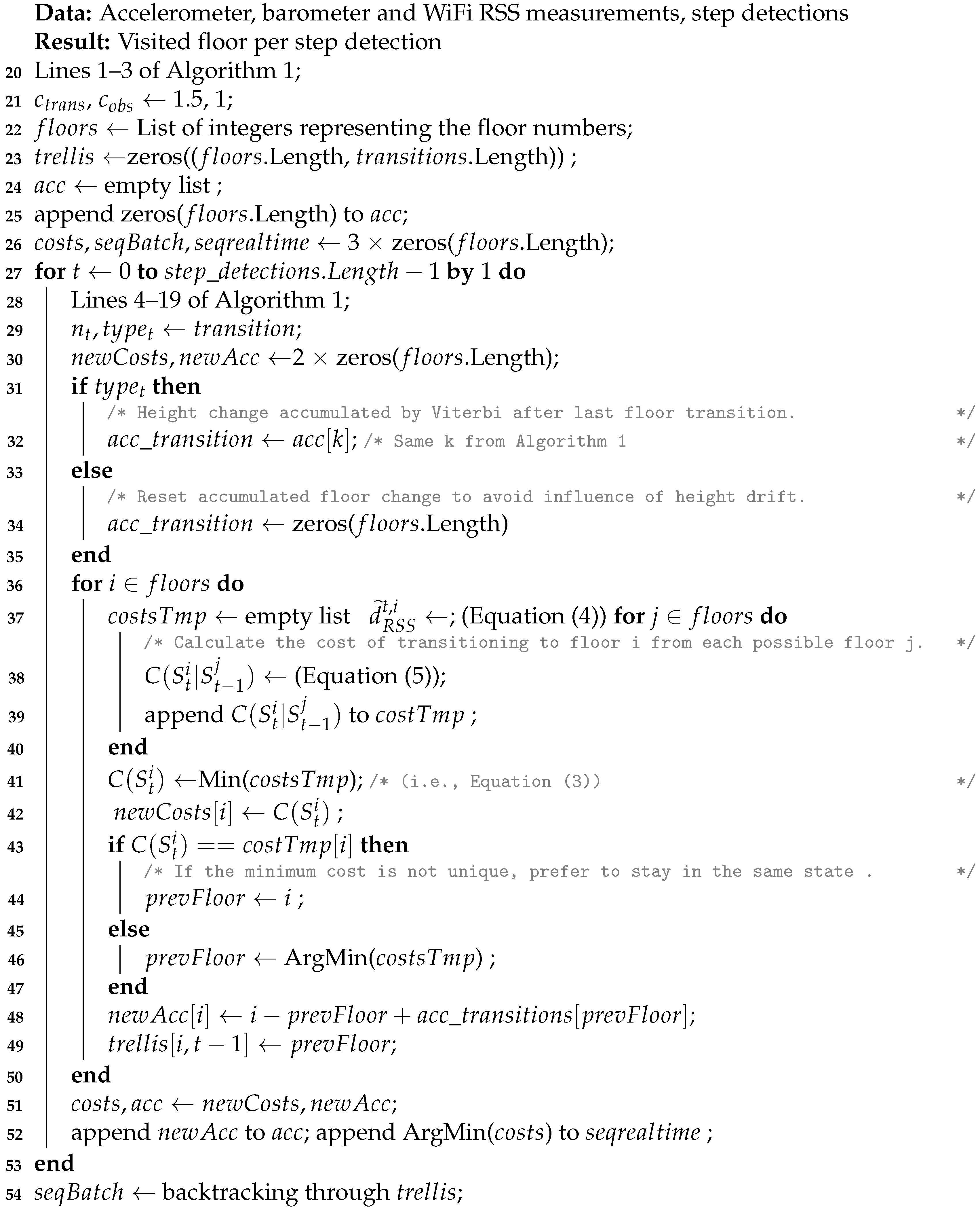 |
3.4. Backtracking Particle Filter with Clustering
3.4.1. Initialization
3.4.2. Propagation
3.4.3. Update
3.4.4. Resampling
3.4.5. Trajectory Estimation with DBSCAN
3.4.6. Tail Update
3.5. Evaluation Configurations
3.5.1. Environment
3.5.2. Validation Approach
3.5.3. Algorithm Configurations
3.5.4. Trajectories
4. Results
4.1. Floor Detection
4.2. Localisation
5. Discussion
- The radio maps were constructed using the WHIPP tool (Section 3.2);
- A random walk was performed on each floor to calibrate the radio maps (Section 3.2). The data from these walks were also used to calibrate the stairs detection algorithm (Section 3.3.2);
- The elevator was taken several times, and the floor change was annotated, to determine the parameters used to estimate the height change (Section 3.3.1);
- A short trajectory (80 m for our tests) of a known length was walked to tune the step length model (Section 3.1).
6. Conclusions
Author Contributions
Funding
Institutional Review Board Statement
Informed Consent Statement
Data Availability Statement
Acknowledgments
Conflicts of Interest
Sample Availability
Abbreviations
| UWB | Ultra-Wideband |
| IMU | Inertial Measurement Unit |
| PDR | Pedestrian Dead Reckoning |
| PF | Particle Filter |
| KDE | Kernel Density Estimator |
| BPF | Backtracking Particle Filter |
| DBSCAN | Density-Based Spatial Clustering for Applications with Noise |
| RSS | Received Signal Strength |
| MBF | Model-Based Fingerprinting |
| AP | Access Point |
| AHRS | Attitude and Heading Reference System |
| WHIPP | WiCA Heuristic Indoor Propagation Prediction |
| NLOS | Non-Line-Of-Sight |
| CDF | Cumulative Distribution Function |
| LP | Low-Pass |
References
- Faheem Zafari, A.G. A Survey of Indoor Localization Systems and Technologies. IEEE Commun. Surv. Tutor. 2019, 21, 2568–2597. [Google Scholar] [CrossRef]
- Alarifi, A.; Al-Salman, A.; Alsaleh, M.; Alnafessah, A.; Alhadhrami, S.; Al-Ammar, M.; Al-Khalifa, H. Ultra Wideband Indoor Positioning Technologies: Analysis and Recent Advances. Sensors 2016, 16, 707. [Google Scholar] [CrossRef] [PubMed]
- Zhang, C.; Kuhn, M.; Merkl, B.; Mahfouz, M.; Fathy, A.E. Development of an UWB Indoor 3D Positioning Radar with Millimeter Accuracy. In Proceedings of the 2006 IEEE MTT-S International Microwave Symposium Digest, San Francisco, CA, USA, 11–16 June 2006; pp. 106–109. [Google Scholar] [CrossRef]
- Schroeer, G. A Real-Time UWB Multi-Channel Indoor Positioning System for Industrial Scenarios. In Proceedings of the 2018 International Conference on Indoor Positioning and Indoor Navigation (IPIN), Nantes, France, 24–27 September 2018; pp. 1–5. [Google Scholar] [CrossRef]
- Poulose, A.; Han, D.S. Feature-Based Deep LSTM Network for Indoor Localization Using UWB Measurements. In Proceedings of the 3rd International Conference on Artificial Intelligence in Information and Communication, ICAIIC 2021, Jeju Island, Korea, 13–16 April 2021; pp. 298–301. [Google Scholar] [CrossRef]
- Luo, J.; Fan, L.; Li, H. Indoor Positioning Systems Based on Visible Light Communication: State of the Art. IEEE Commun. Surv. Tutor. 2017, 19, 2871–2893. [Google Scholar] [CrossRef]
- Joseph, D.; Ijaz, M. Efficient 3D trilateration algorithm for visible light positioning. J. Opt. 2019, 21, 05LT01. [Google Scholar]
- Xu, J.B.; Zhang, H.Q.; Zhang, J.L. Self-adapting multi-fingerprints joint indoor positioning algorithm in WLAN based on database of AP ID. In Proceedings of the 33rd Chinese Control Conference, Nanjing, China, 28–30 July 2014; pp. 534–538. [Google Scholar] [CrossRef]
- Costilla-Reyes, O.; Namuduri, K. Dynamic Wi-Fi fingerprinting indoor positioning system. In Proceedings of the 2014 International Conference on Indoor Positioning and Indoor Navigation (IPIN), Busan, Korea, 27–30 October 2014; pp. 271–280. [Google Scholar] [CrossRef]
- Ferreira, J.C.; Resende, R.; Martinho, S. Beacons and BIM models for indoor guidance and location. Sensors 2018, 18, 4374. [Google Scholar] [CrossRef]
- Jiménez, A.R.; Seco, F.; Prieto, J.C.; Guevara, J. Indoor pedestrian navigation using an INS/EKF framework for yaw drift reduction and a foot-mounted IMU. In Proceedings of the 2010 7th Workshop on Positioning, Navigation and Communication, Dresden, Germany, 11–12 March 2010; pp. 135–143. [Google Scholar] [CrossRef]
- Gobana, F.W. Survey of Inertial/magnetic Sensors Based pedestrian dead reckoning by multi-sensor fusion method. In Proceedings of the 2018 International Conference on Information and Communication Technology Convergence (ICTC), Jeju Island, Korea, 17–19 October 2018; pp. 1327–1334. [Google Scholar] [CrossRef]
- Groves, P.; Pulford, G.; Littlefield, C.; Nash, D.; Mather, C. Inertial Navigation Versus Pedestrian Dead Reckoning: Optimizing the Integration. In Proceedings of the 20th International Technical Meeting of the Satellite Division of The Institute of Navigation (ION GNSS 2007), Fort Worth, TX, USA, 25–28 September 2007; Volume 2. [Google Scholar]
- Ju, H.J.; Lee, M.S.; Park, C.G.; Lee, S.; Park, S. Advanced Heuristic Drift Elimination for indoor pedestrian navigation. In Proceedings of the 2014 International Conference on Indoor Positioning and Indoor Navigation (IPIN), Busan, Korea, 27–30 October 2014; pp. 729–732. [Google Scholar] [CrossRef]
- Li, Y.; Song, Q.; Ma, M.; Gu, Y. Near Real Time Heading Drift Correction for indoor pedestrian tracking based on sequence detection. In Proceedings of the 2016 International Conference on Indoor Positioning and Indoor Navigation (IPIN), Alcala de Henares, Spain, 4–7 October 2016; pp. 1–4. [Google Scholar] [CrossRef]
- Zhu, R.; Wang, Y.; Yu, B.; Gan, X.; Jia, H.; Wang, B. Enhanced Heuristic Drift Elimination with Adaptive Zero-Velocity Detection and Heading Correction Algorithms for Pedestrian Navigation. Sensors 2020, 20, 951. [Google Scholar] [CrossRef]
- Kang, W.; Han, Y. SmartPDR: Smartphone-Based Pedestrian Dead Reckoning for Indoor Localization. IEEE Sens. J. 2015, 15, 2906–2916. [Google Scholar] [CrossRef]
- Hu, G.; Zhang, W.; Wan, H.; Li, X. Improving the Heading Accuracy in Indoor Pedestrian Navigation Based on a Decision Tree and Kalman Filter. Sensors 2020, 20, 1578. [Google Scholar] [CrossRef]
- Qian, J.; Pei, L.; Ma, J.; Ying, R.; Liu, P. Vector Graph Assisted Pedestrian Dead Reckoning Using an Unconstrained Smartphone. Sensors 2015, 15, 5032–5057. [Google Scholar] [CrossRef]
- Racko, J.; Brida, P.; Perttula, A.; Parviainen, J.; Collin, J. Pedestrian Dead Reckoning with Particle Filter for handheld smartphone. In Proceedings of the 2016 International Conference on Indoor Positioning and Indoor Navigation (IPIN), Alcala de Henares, Spain, 4–7 October 2016; pp. 1–7. [Google Scholar] [CrossRef]
- Hölzke, F.; Wolff, J.P.; Golatowski, F.; Haubelt, C. Low-complexity online correction and calibration of pedestrian dead reckoning using map matching and GPS. Geo-Spat. Inf. Sci. 2019, 22, 1–14. [Google Scholar] [CrossRef]
- Wang, X.; Chen, Q.; Yang, M.; Huiyu, J. A Multi-Mode PDR Perception and Positioning System Assisted by Map Matching and Particle Filtering. Isprs Int. J. Geo Inf. 2020, 9, 93. [Google Scholar] [CrossRef]
- Fetzer, T.; Ebner, F.; Bullmann, M.; Deinzer, F.; Grzegorzek, M. Smartphone-Based Indoor Localization within a 13th Century Historic Building. Sensors 2018, 18, 4095. [Google Scholar] [CrossRef] [PubMed]
- Pipelidis, G.; Tsiamitros, N.; Gentner, C.; Ahmed, D.B.; Prehofer, C. A Novel Lightweight Particle Filter for Indoor Localization. In Proceedings of the 2019 International Conference on Indoor Positioning and Indoor Navigation (IPIN), Pisa, Italy, 30 September–3 October 2019; pp. 1–8. [Google Scholar] [CrossRef]
- Nurminen, H.; Ristimäki, A.; Ali-Löytty, S.; Piché, R. Particle filter and smoother for indoor localization. In Proceedings of the 2013 International Conference on Indoor Positioning and Indoor Navigation, IPIN 2013, Montbeliard, France, 28–31 October 2013. [Google Scholar] [CrossRef]
- Wu, Y.; Zhu, H.B.; Du, Q.X.; Tang, S.M. A Survey of the Research Status of Pedestrian Dead Reckoning Systems Based on Inertial Sensors. Int. J. Autom. Comput. 2019, 16, 65–83. [Google Scholar] [CrossRef]
- Gansemer, S.; Hakobyan, S.; Püschel, S.; Großmann, U. 3D WLAN indoor positioning in multi-storey buildings. In Proceedings of the 2009 IEEE International Workshop on Intelligent Data Acquisition and Advanced Computing Systems: Technology and Applications, Rende, Italy, 21–23 September 2009; pp. 669–672. [Google Scholar] [CrossRef]
- Wang, B.; Liu, X.; Yu, B.; Jia, R.; Gan, X. Pedestrian Dead Reckoning Based on Motion Mode Recognition Using a Smartphone. Sensors 2018, 18, 1811. [Google Scholar] [CrossRef]
- Inderst, F.; Pascucci, F.; Santoni, M. 3D Pedestrian Dead Reckoning and Activity Classification Using Waist-Mounted Inertial Measurement Unit. In Proceedings of the 2015 International Conference on Indoor Positioning and Indoor Navigation, Banff, AB, Canada, 13–16 October 2015. [Google Scholar] [CrossRef]
- Tanigawa, M.; Luinge, H.; Schipper, L.; Slycke, P. Drift-free dynamic height sensor using MEMS IMU aided by MEMS pressure sensor. In Proceedings of the 2008 5th Workshop on Positioning, Navigation and Communication, Hannover, Germany, 27 March 2008; pp. 191–196. [Google Scholar] [CrossRef]
- Zhao, H.Y.; Cheng, W.; Yang, N.; Qiu, S.; Wang, Z.; Wang, J. Smartphone-Based 3D Indoor Pedestrian Positioning through Multi-Modal Data Fusion. Sensors 2019, 19, 4554. [Google Scholar] [CrossRef]
- Widyawan; Klepal, M.; Beauregard, S. A Backtracking Particle Filter for fusing building plans with PDR displacement estimates. In Proceedings of the 2008 5th Workshop on Positioning, Navigation and Communication, Hannover, Germany, 27 March 2008; pp. 207–212. [Google Scholar] [CrossRef]
- Ester, M.; Kriegel, H.P.; Sander, J.; Xu, X. A Density-Based Algorithm for Discovering Clusters in Large Spatial Databases with Noise. In Proceedings of the Second International Conference on Knowledge Discovery and Data Mining, Portland, OR, USA, 2–4 August 1996; AAAI Press: Phoenix, AZ, USA, 1996; pp. 226–231. [Google Scholar]
- Kok, M.; Hol, J.D.; Schön, T.B. Using inertial sensors for position and orientation estimation. Found. Trends Signal Process. 2017, 11, 1–153. [Google Scholar] [CrossRef]
- Diaz, E.; de Ponte Müller, F.; Jiménez, A.; Zampella, F. Evaluation of AHRS algorithms for inertial personal localization in industrial environments. Proc. IEEE Int. Conf. Ind. Technol. 2015, 2015, 3412–3417. [Google Scholar] [CrossRef]
- Poulose, A.; Senouci, B.; Han, D.S. Performance Analysis of Sensor Fusion Techniques for Heading Estimation Using Smartphone Sensors. IEEE Sensors J. 2019, 19, 12369–12380. [Google Scholar] [CrossRef]
- Poulose, A.; Eyobu, O.S.; Han, D.S. An indoor position-estimation algorithm using smartphone IMU sensor data. IEEE Access 2019, 7, 11165–11177. [Google Scholar] [CrossRef]
- Deng, Z.A.; Wang, G.; Hu, Y.; Wu, D. Heading Estimation for Indoor Pedestrian Navigation Using a Smartphone in the Pocket. Sensors 2015, 15, 21518–21536. [Google Scholar] [CrossRef]
- Kang, X.; Huang, B.; Qi, G. A novel walking detection and step counting algorithm using unconstrained smartphones. Sensors 2018, 18, 297. [Google Scholar] [CrossRef]
- Weinberg, H. Using the ADXL202 in Pedometer and Personal Navigation Applications; Analog Devices, Inc.: Norwood, MA, USA, 2002. [Google Scholar]
- Ho, N.H.; Truong, P.; Jeong, G.M. Step-Detection and Adaptive Step-Length Estimation for Pedestrian Dead-Reckoning at Various Walking Speeds Using a Smartphone. Sensors 2016, 16, 1423. [Google Scholar] [CrossRef] [PubMed]
- Ebner, F.; Fetzer, T.; Deinzer, F.; Grzegorzek, M. On prior navigation knowledge in multi sensor indoor localisation. In Proceedings of the 2016 19th International Conference on Information Fusion (FUSION), Heidelberg, Germany, 5–8 July 2016; pp. 557–564. [Google Scholar]
- Fetzer, T.; Ebner, F.; Deinzer, F.; Grzegorzek, M. Recovering from sample impoverishment in context of indoor localisation. In Proceedings of the 2017 International Conference on Indoor Positioning and Indoor Navigation (IPIN), Sapporo, Japan, 18–21 September 2017; pp. 1–8. [Google Scholar] [CrossRef]
- Poulose, A.; Kim, J.; Han, D.S. A sensor fusion framework for indoor localization using smartphone sensors and Wi-Fi RSSI measurements. Appl. Sci. 2019, 9, 4379. [Google Scholar] [CrossRef]
- Wang, J.; Park, J.G. A novel indoor ranging algorithm based on a received signal strength indicator and channel state information using an extended kalman filter. Appl. Sci. 2020, 10, 3687. [Google Scholar] [CrossRef]
- Hilsenbeck, S.; Bobkov, D.; Schroth, G.; Huitl, R.; Steinbach, E. Graph-based data fusion of pedometer and wiFi measurements for mobile indoor positioning. In Proceedings of the UbiComp 2014—Proceedings of the 2014 ACM International Joint Conference on Pervasive and Ubiquitous Computing, Seattle, WA, USA, 13–17 September 2014; pp. 147–158. [Google Scholar] [CrossRef]
- Shi, L.; Wang, Y.; Liu, G.; Chen, S.; Zhao, Y.; Shi, Y. A Fusion Algorithm of Indoor Positioning Based on PDR and RSS Fingerprint. IEEE Sens. J. 2018, 18, 9691–9698. [Google Scholar] [CrossRef]
- Yu, J.; Na, Z.; Liu, X.; Deng, Z. WiFi/PDR-integrated indoor localization using unconstrained smartphones. EURASIP J. Wirel. Commun. Netw. 2019, 2019. [Google Scholar] [CrossRef]
- Poulose, A.; Han, D.S. Hybrid indoor localization using IMU sensors and smartphone camera. Sensors 2019, 19, 5084. [Google Scholar] [CrossRef]
- Gu, F.; Kealy, A.; Khoshelham, K.; Shang, J. User-Independent Motion State Recognition Using Smartphone Sensors. Sensors 2015, 15, 30636–30652. [Google Scholar] [CrossRef]
- Choi, J.; Choi, Y.S. Calibration-Free Positioning Technique Using Wi-Fi Ranging and Built-In Sensors of Mobile Devices. IEEE Internet Things J. 2021, 8, 541–554. [Google Scholar] [CrossRef]
- Li, B.; Harvey, B.; Gallagher, T. Using barometers to determine the height for indoor positioning. In Proceedings of the International Conference on Indoor Positioning and Indoor Navigation, Montbeliard, France, 28–31 October 2013; pp. 1–7. [Google Scholar] [CrossRef]
- Yan, J.; He, G.; Basiri, A.; Hancock, C. 3-D Passive-Vision-Aided Pedestrian Dead Reckoning for Indoor Positioning. IEEE Trans. Instrum. Meas. 2020, 69, 1370–1386. [Google Scholar] [CrossRef]
- Kim, S. Floor Detection Using a Barometer Sensor in a Smartphone. In Proceedings of the 2017 International Conference on Indoor Positioning and Indoor Navigation, Sapporo, Japan, 18–21 September 2017. [Google Scholar]
- Chai, W.; Chen, C.; Edwan, E.; Zhang, J.; Loffeld, O. 2D/3D indoor navigation based on multi-sensor assisted pedestrian navigation in Wi-Fi environments. In Proceedings of the 2012 Ubiquitous Positioning, Indoor Navigation, and Location Based Service (UPINLBS), Helsinki, Finland, 3–4 October 2012; pp. 1–7. [Google Scholar] [CrossRef]
- Ebner, F.; Fetzer, T.; Deinzer, F.; Köping, L.; Grzegorzek, M. Multi sensor 3D indoor localisation. In Proceedings of the 2015 International Conference on Indoor Positioning and Indoor Navigation (IPIN), Banff, AB, Canada, 13–16 October 2015; pp. 1–11. [Google Scholar] [CrossRef]
- Nguyen-Huu, K.; Lee, S.W. A Multi-Floor Indoor Pedestrian Localization Method Using Landmarks Detection for Different Holding Styles. Mob. Inf. Syst. 2021, 2021. [Google Scholar] [CrossRef]
- Baird, W. An introduction to inertial navigation. Am. J. Phys. 2009, 77, 844–847. [Google Scholar] [CrossRef][Green Version]
- Liu, D.; Pei, L.; Qian, J.; Wang, L.; Liu, C.; Liu, P.; Yu, W. Simplified Ellipsoid Fitting-Based Magnetometer Calibration for Pedestrian Dead Reckoning. In China Satellite Navigation Conference (CSNC) 2016 Proceedings: Volume II; Springer: Singapore, 2016; Volume 2, pp. 473–486. [Google Scholar] [CrossRef]
- Position Sensors. Available online: https://developer.android.com/guide/topics/sensors/sensors_position (accessed on 24 June 2021).
- IMEC Ghent University. WiCa Heuristic Indoor Propagation Prediction Tool (WHIPP). Available online: https://www.waves.intec.ugent.be/exposure-tool/expert-edition (accessed on 2 July 2021).
- Plets, D.; Joseph, W.; Vanhecke, K.; Tanghe, E.; Martens, L. Coverage prediction and optimization algorithms for indoor environments. EURASIP J. Wirel. Commun. Netw. 2012, 2012. [Google Scholar] [CrossRef]
- Laoudias, C.; Piché, R.; Panayiotou, C. Device signal strength self-calibration using histograms. In Proceedings of the 2012 International Conference on Indoor Positioning and Indoor Navigation, IPIN 2012—Conference Proceedings, Sydney, Australia, 13–15 November 2012; pp. 1–8. [Google Scholar] [CrossRef]
- Yang, T.; Kaji, K.; Kawaguchi, N. Elevator Acceleration Sensing: Design and Estimation Recognition Algorithm Using Crowdsourcing. In Proceedings of the 2013 IEEE 37th Annual Computer Software and Applications Conference Workshops, Kyoto, Japan, 22–26 July 2013; pp. 534–539. [Google Scholar] [CrossRef]
- Standards and Jurisdiction. Available online: https://www.escaliers-echelle-europeenne.com/en/tips/standards-jurisdiction/ (accessed on 16 April 2021).
- Forney, G. The viterbi algorithm. Proc. IEEE 1973, 61, 268–278. [Google Scholar] [CrossRef]
- Doucet, A.; Johansen, A. A Tutorial on Particle Filtering and Smoothing: Fifteen Years Later. Handb. Nonlinear Filter. 2009, 12, 3. [Google Scholar]
- Jiménez, A.R.; Seco, F.; Torres-Sospedra, J. Tools for smartphone multi-sensor data registration and GT mapping for positioning applications. In Proceedings of the 2019 International Conference on Indoor Positioning and Indoor Navigation (IPIN), Pisa, Italy, 30 September–3 October 2019; pp. 1–8. [Google Scholar] [CrossRef]
- Poulose, A.; Kim, J.; Han, D.S. Indoor Localization with Smartphones: Magnetometer Calibration. In Proceedings of the 2019 IEEE International Conference on Consumer Electronics (ICCE), Las Vegas, NV, USA, 11–13 January 2019; pp. 1–3. [Google Scholar] [CrossRef]
- Januszkiewicz, L. Analysis of Human Body Shadowing Effect on Wireless Sensor Networks Operating in the 2.4 GHz Band. Sensors 2018, 2018, 3412. [Google Scholar] [CrossRef] [PubMed]
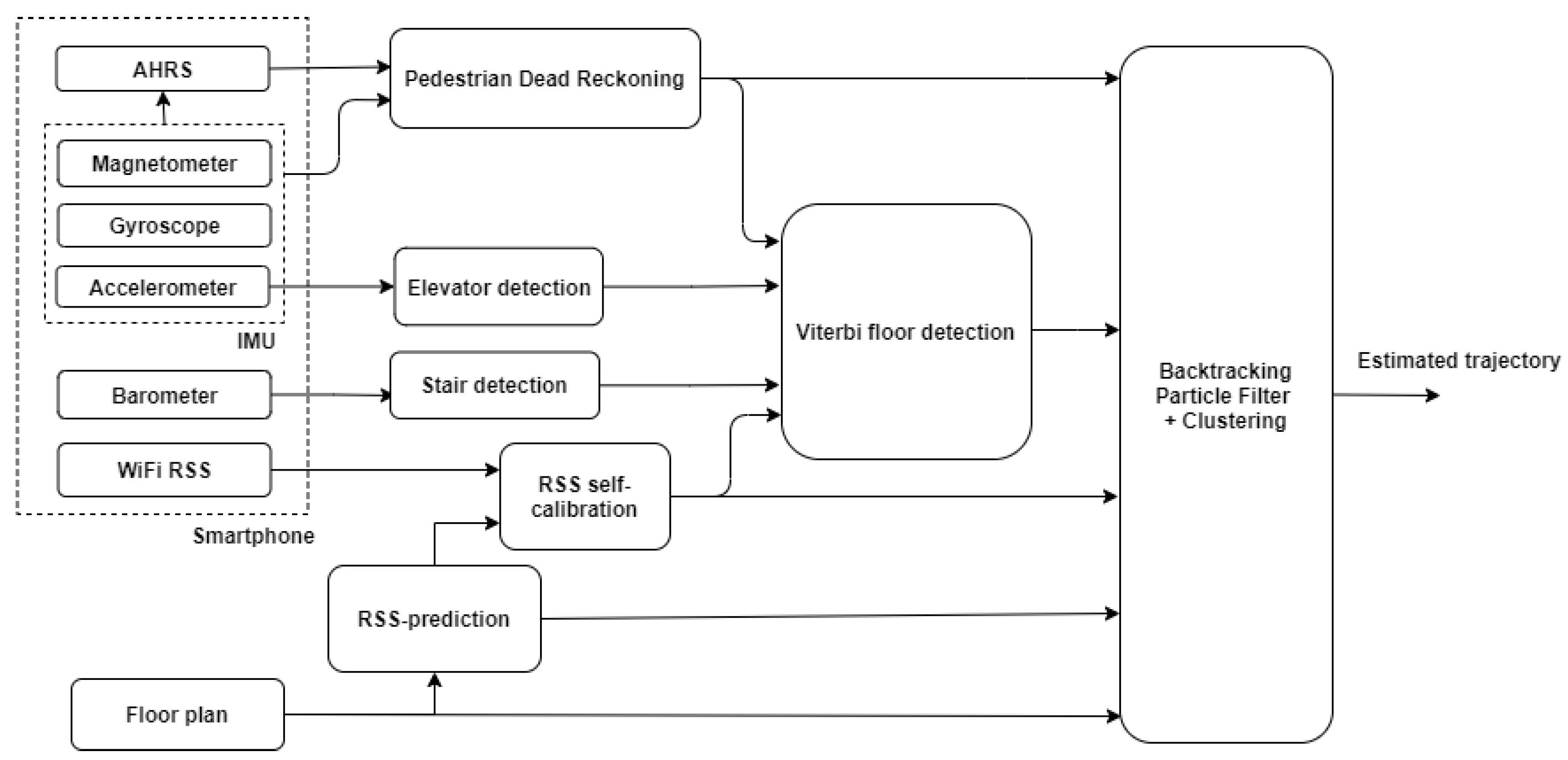


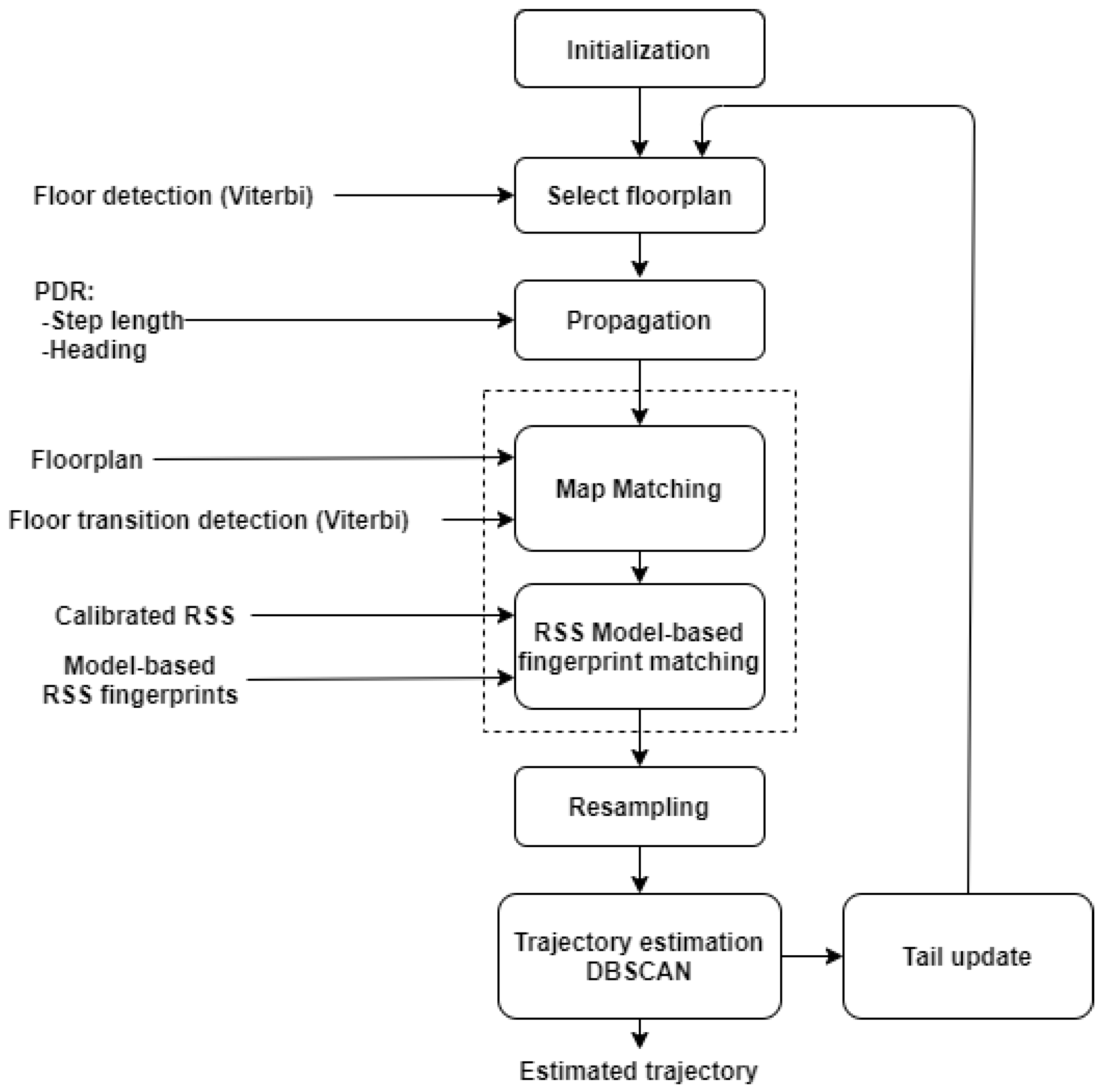
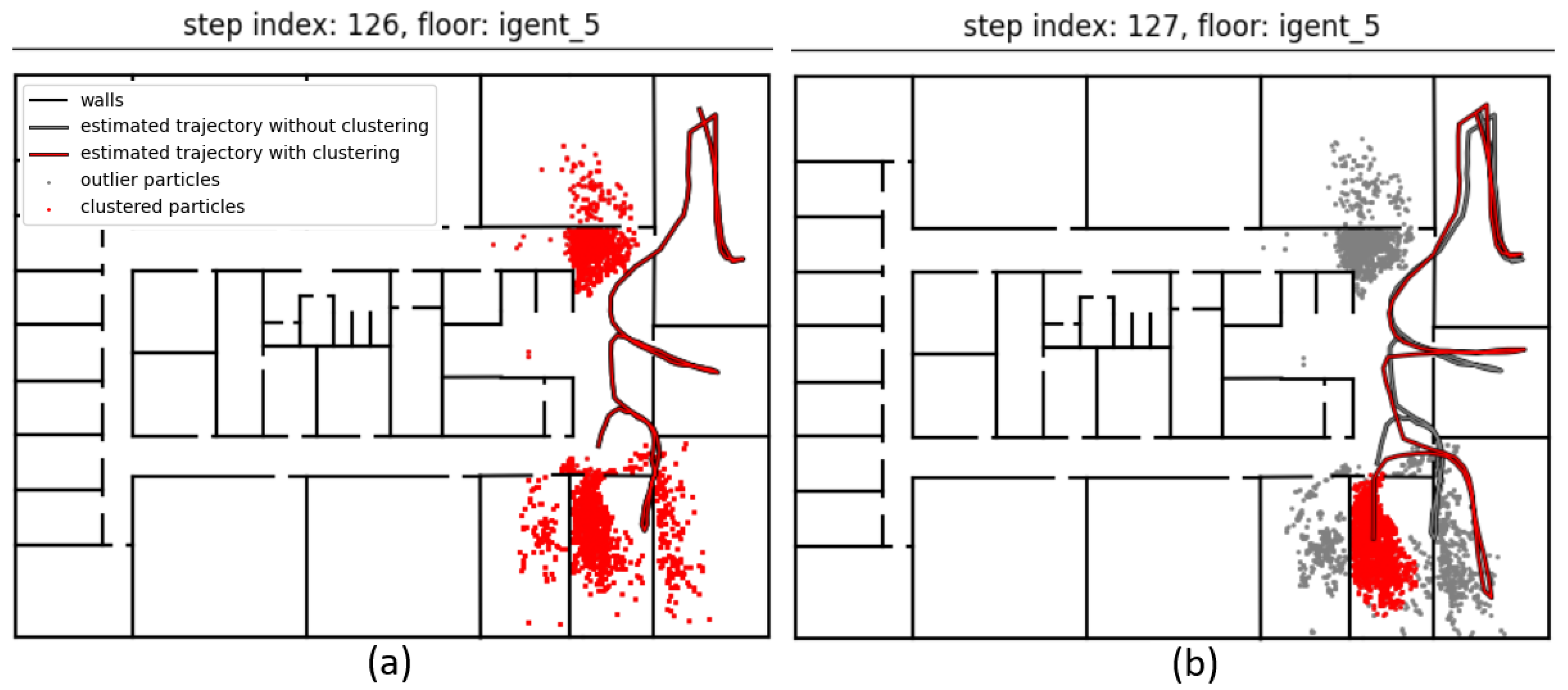

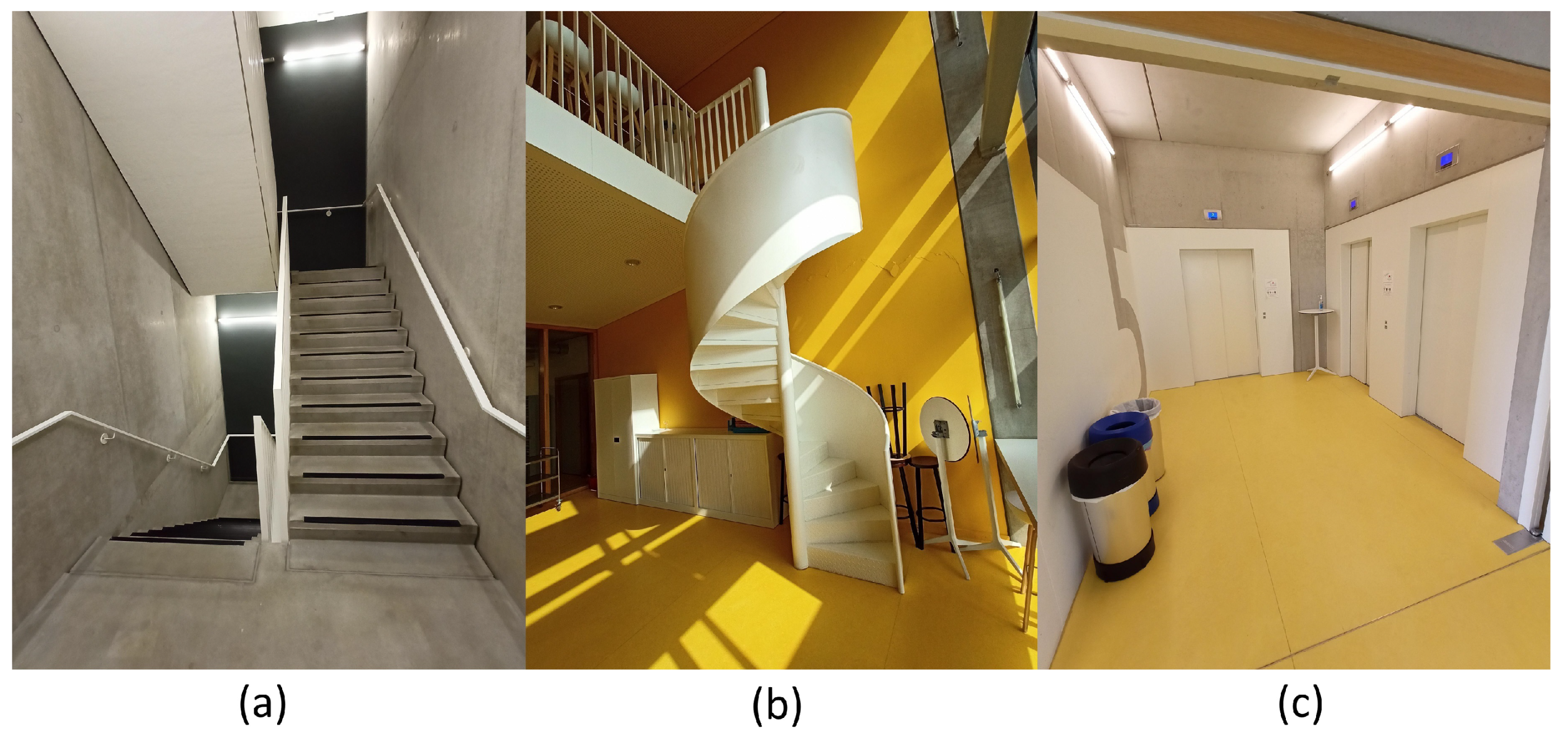
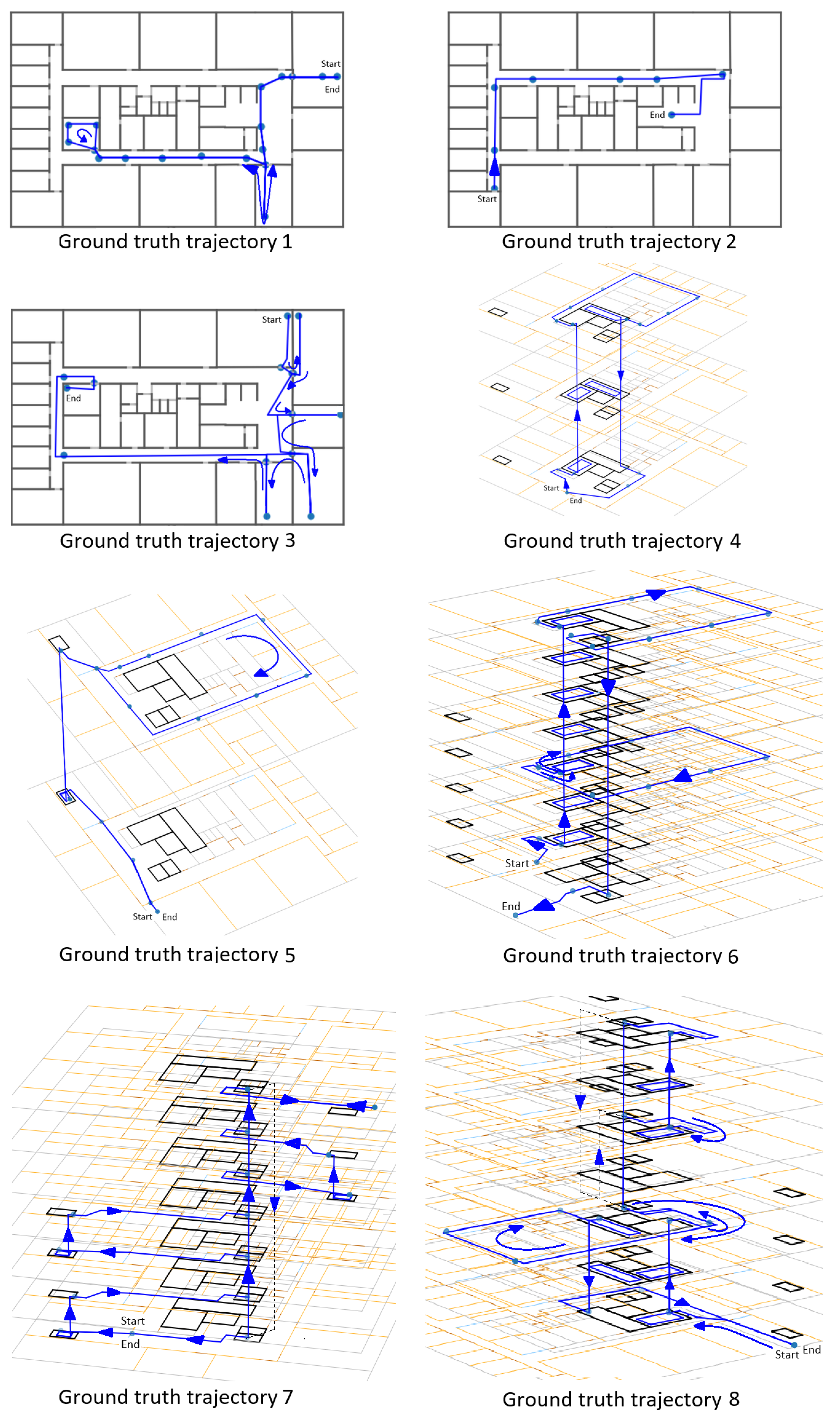
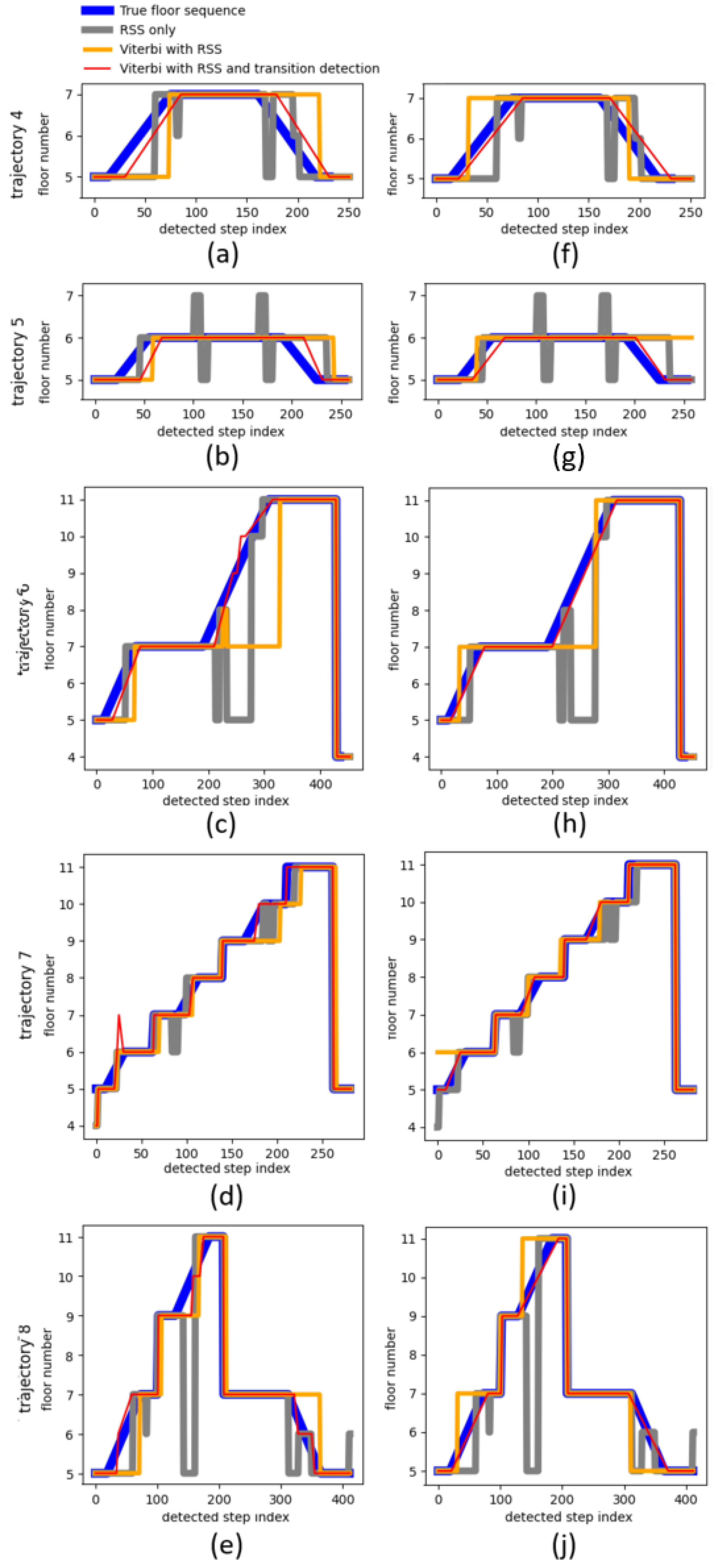


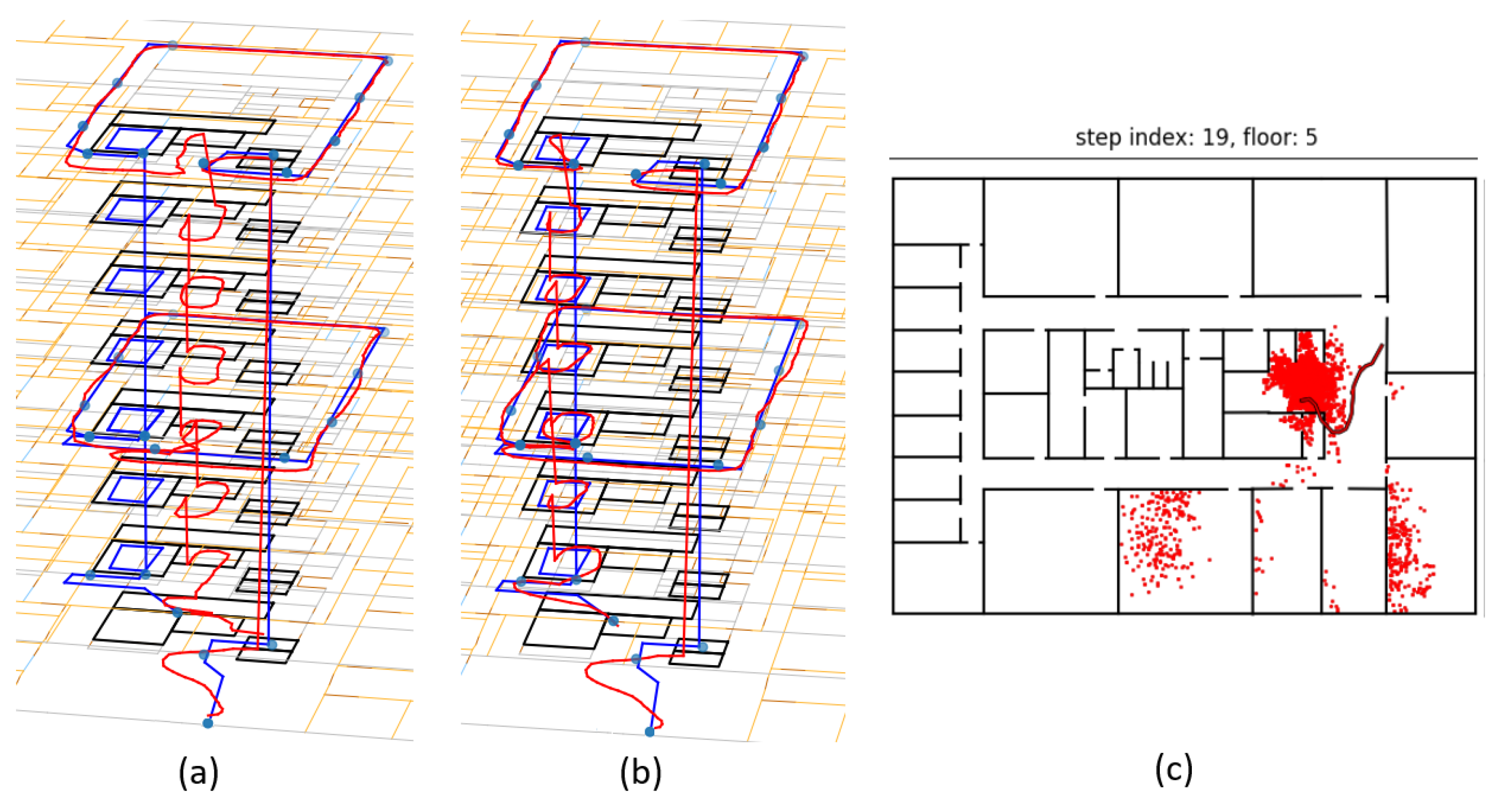
| Algorithm | Parameter | Value |
|---|---|---|
| BPF | ||
| BPF | N | 1000 |
| BPF | 0.15 m | |
| BPF | ||
| DBSCAN | ||
| DBSCAN | 0.05 N | |
| WiFi RSS MBF | 11 dB | |
| Stairs detection | 3 | |
| Stairs detection | 0.8 m (GS5), 0.5 m (GS7) | |
| Stairs detection | 17 (GS5), 11 (GS7) | |
| Floor detection | 4 | |
| Floor detection | 1 |
| Trajectory Details | Floor Details | ||||||
|---|---|---|---|---|---|---|---|
| # | * Duration (s) | * Steps Detected | Length | Evaluation Points | Floor Number Sequence | Transition Types | * Transition Time |
| 1 | 114 | 180 | 122 | 35 | 5 | - | - |
| 2 | 50 | 83 | 53 | 8 | 5 | - | - |
| 3 | 142 | 219 | 138 | 17 | 5 | - | - |
| 4 | 170 | 250 | 135 | 16 | 5, 7, 5 | S2, S1 | 76 |
| 5 | 156 | 251 | 136 | 22 | 5, 6, 5 | S3, S3 | 32 |
| 6 | 382 | 456 | 271 | 29 | 5, 7, 11, 4 | S2, S2, E2 | 141 |
| 7 | 350 | 282 | 143 | 16 | 5, 6, 7, 8, 9, 10, 11, 5 | S3, E3, S3, E3, S4, E3, E3 | 129 |
| 8 | 380 | 412 | 232 | 17 | 5, 7, 9, 11, 7, 5 | S2, E3, S2, E3, S1 | 150 |
| True Activity | ||||||
|---|---|---|---|---|---|---|
| Walking | Stairs Up | Stairs Down | Elevator Up | Elevator Down | ||
| Detected Activity | Walking | 89% | 5% | 8% | 3% | 6% |
| Stairs Up | 6% | 95% | 0% | 0% | 0% | |
| Stairs Down | 3% | 0% | 92% | 0% | 0% | |
| Elevator Up | 1% | 0% | 0% | 97% | 0% | |
| Elevator Down | 1% | 0% | 0% | 0% | 94% | |
| True Activity | ||||||
|---|---|---|---|---|---|---|
| Walking | Stairs Up | Stairs Down | Elevator Up | Elevator Down | ||
| Detected Activity | Walking | 89% | 35% | 33% | 3% | 6% |
| Stairs Up | 6% | 65% | 0% | 0% | 0% | |
| Stairs Down | 3% | 0% | 67% | 0% | 0% | |
| Elevator Up | 1% | 0% | 0% | 97% | 0% | |
| Elevator Down | 1% | 0% | 0% | 0% | 94% | |
| Difference between True and Detected Floor Number | |||||||||
|---|---|---|---|---|---|---|---|---|---|
| 0 | 1 | 2 | 3 | 4 | 5 | 6 | 7 | ||
| Algorithm | RSS only (Euclidean distance metric) | 91.6% | 6.8% | 0.2% | 0% | 1.0% | 0.1% | 0.3% | 0.1% |
| Viterbi: RSS (real-time) | 85.3% | 8.4% | 3.5% | 0% | 2.1% | 0% | 0.5% | 0.2% | |
| Viterbi: RSS (batch) | 94.1% | 3.8% | 1.0% | 0% | 0.7% | 0% | 0.4% | 0% | |
| Viterbi: RSS and floor transition detection (real-time) | 99.1% | 0.9% | 0% | 0% | 0% | 0% | 0% | 0% | |
| Viterbi: RSS and floor transition detection (batch) | 99.7% | 0.3% | 0% | 0% | 0% | 0% | 0% | 0% | |
| Mean (m) | P50 (m) | P75 (m) | P90 (m) | |
|---|---|---|---|---|
| Batch—clustering | 1.6 | 1.3 | 2.0 | 2.9 |
| Batch—no clustering | 1.8 | 1.5 | 2.5 | 3.4 |
| Real-time—clustering | 3.5 | 3.0 | 4.8 | 7.1 |
| Real-time—no clustering | 4.1 | 3.6 | 5.4 | 7.7 |
Publisher’s Note: MDPI stays neutral with regard to jurisdictional claims in published maps and institutional affiliations. |
© 2021 by the authors. Licensee MDPI, Basel, Switzerland. This article is an open access article distributed under the terms and conditions of the Creative Commons Attribution (CC BY) license (https://creativecommons.org/licenses/by/4.0/).
Share and Cite
De Cock, C.; Joseph, W.; Martens, L.; Trogh, J.; Plets, D. Multi-Floor Indoor Pedestrian Dead Reckoning with a Backtracking Particle Filter and Viterbi-Based Floor Number Detection. Sensors 2021, 21, 4565. https://doi.org/10.3390/s21134565
De Cock C, Joseph W, Martens L, Trogh J, Plets D. Multi-Floor Indoor Pedestrian Dead Reckoning with a Backtracking Particle Filter and Viterbi-Based Floor Number Detection. Sensors. 2021; 21(13):4565. https://doi.org/10.3390/s21134565
Chicago/Turabian StyleDe Cock, Cedric, Wout Joseph, Luc Martens, Jens Trogh, and David Plets. 2021. "Multi-Floor Indoor Pedestrian Dead Reckoning with a Backtracking Particle Filter and Viterbi-Based Floor Number Detection" Sensors 21, no. 13: 4565. https://doi.org/10.3390/s21134565
APA StyleDe Cock, C., Joseph, W., Martens, L., Trogh, J., & Plets, D. (2021). Multi-Floor Indoor Pedestrian Dead Reckoning with a Backtracking Particle Filter and Viterbi-Based Floor Number Detection. Sensors, 21(13), 4565. https://doi.org/10.3390/s21134565







